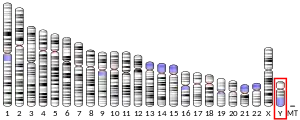| TSPY1 | |||||||||||||||||||||||||||||||||||||||||||||||||||
|---|---|---|---|---|---|---|---|---|---|---|---|---|---|---|---|---|---|---|---|---|---|---|---|---|---|---|---|---|---|---|---|---|---|---|---|---|---|---|---|---|---|---|---|---|---|---|---|---|---|---|---|
| Identifiers | |||||||||||||||||||||||||||||||||||||||||||||||||||
| Aliases | TSPY1, CT78, DYS14, TSPY, pJA923, testis specific protein, Y-linked 1, testis specific protein Y-linked 1 | ||||||||||||||||||||||||||||||||||||||||||||||||||
| External IDs | OMIM: 480100 HomoloGene: 87844 GeneCards: TSPY1 | ||||||||||||||||||||||||||||||||||||||||||||||||||
| |||||||||||||||||||||||||||||||||||||||||||||||||||
| |||||||||||||||||||||||||||||||||||||||||||||||||||
| |||||||||||||||||||||||||||||||||||||||||||||||||||
| |||||||||||||||||||||||||||||||||||||||||||||||||||
| Wikidata | |||||||||||||||||||||||||||||||||||||||||||||||||||
| |||||||||||||||||||||||||||||||||||||||||||||||||||
Testis-specific Y-encoded protein 1 is a protein that in humans is encoded by the TSPY1 gene.[3]
The protein encoded by this gene is found only in testicular tissue and may be involved in spermatogenesis. Approximately 35 copies of this gene are present in humans, but only a single, nonfunctional orthologous gene is found in mice. Two transcript variants encoding different isoforms have been found for this gene.[4] The protein is strongly overexpressed in gonadoblastoma.[5]
See also
- TSPYL1: TSPY1 like protein
References
- 1 2 3 GRCh38: Ensembl release 89: ENSG00000258992 - Ensembl, May 2017
- ↑ "Human PubMed Reference:". National Center for Biotechnology Information, U.S. National Library of Medicine.
- ↑ "Entrez Gene: TSPY1 Testis specific protein, Y-linked 1".
- ↑ "TSPY1 testis specific protein Y-linked 1 [Homo sapiens (human)] - Gene - NCBI".
- ↑ Schnieders F, Dörk T, Arnemann J, et al. (1997). "Testis-specific protein, Y-encoded (TSPY) expression in testicular tissues". Hum. Mol. Genet. 5 (11): 1801–7. doi:10.1093/hmg/5.11.1801. PMID 8923009.
Further reading
- Chandley AC, Cooke HJ (1995). "Human male fertility--Y-linked genes and spermatogenesis". Hum. Mol. Genet. 3. Spec No: 1449–52. doi:10.1093/hmg/3.suppl_1.1449. PMID 7849736.
- Vogel T, Schmidtke J (1998). "Structure and function of TSPY, the Y-chromosome gene coding for the "testis-specific protein"". Cytogenet. Cell Genet. 80 (1–4): 209–13. doi:10.1159/000014982. PMID 9678360. S2CID 46875273.
- Lau YF (2000). "Gonadoblastoma, testicular and prostate cancers, and the TSPY gene". Am. J. Hum. Genet. 64 (4): 921–7. doi:10.1086/302353. PMC 1377814. PMID 10090875.
- Zhang JS, Yang-Feng TL, Muller U, et al. (1993). "Molecular isolation and characterization of an expressed gene from the human Y chromosome". Hum. Mol. Genet. 1 (9): 717–26. doi:10.1093/hmg/1.9.717. PMID 1284595.
- Arnemann J, Jakubiczka S, Thüring S, Schmidtke J (1992). "Cloning and sequence analysis of a human Y-chromosome-derived, testicular cDNA, TSPY". Genomics. 11 (1): 108–14. doi:10.1016/0888-7543(91)90107-P. PMID 1765369.
- Arnemann J, Epplen JT, Cooke HJ, et al. (1988). "A human Y-chromosomal DNA sequence expressed in testicular tissue". Nucleic Acids Res. 15 (21): 8713–24. doi:10.1093/nar/15.21.8713. PMC 306400. PMID 3479749.
- Manz E, Schnieders F, Brechlin AM, Schmidtke J (1993). "TSPY-related sequences represent a microheterogeneous gene family organized as constitutive elements in DYZ5 tandem repeat units on the human Y chromosome". Genomics. 17 (3): 726–31. doi:10.1006/geno.1993.1393. PMID 8244388.
- Kim HS, Takenaka O (1996). "A comparison of TSPY genes from Y-chromosomal DNA of the great apes and humans: sequence, evolution, and phylogeny". Am. J. Phys. Anthropol. 100 (3): 301–9. doi:10.1002/(SICI)1096-8644(199607)100:3<301::AID-AJPA1>3.0.CO;2-X. PMID 8798990.
- Vogt PH, Affara N, Davey P, et al. (1998). "Report of the Third International Workshop on Y Chromosome Mapping 1997. Heidelberg, Germany, April 13-16, 1997". Cytogenet. Cell Genet. 79 (1–2): 1–20. doi:10.1159/000134680. PMID 9533010.
- Vogel T, Dittrich O, Mehraein Y, et al. (1998). "Murine and human TSPYL genes: novel members of the TSPY-SET-NAP1L1 family". Cytogenet. Cell Genet. 81 (3–4): 265–70. doi:10.1159/000015042. PMID 9730615. S2CID 46829106.
- Lau YF, Zhang J (2000). "Expression analysis of thirty one Y chromosome genes in human prostate cancer". Mol. Carcinog. 27 (4): 308–21. doi:10.1002/(SICI)1098-2744(200004)27:4<308::AID-MC9>3.0.CO;2-R. PMID 10747295. S2CID 23677925.
- Ratti A, Stuppia L, Gatta V, et al. (2000). "Characterization of a new TSPY gene family member in Yq (TSPYq1)". Cytogenet. Cell Genet. 88 (1–2): 159–62. doi:10.1159/000015510. PMID 10773691. S2CID 20806022.
- Dechend F, Williams G, Skawran B, et al. (2001). "TSPY variants in six loci on the human Y chromosome". Cytogenet. Cell Genet. 91 (1–4): 67–71. doi:10.1159/000056821. PMID 11173833. S2CID 21757455.
- Lau Y, Chou P, Iezzoni J, et al. (2001). "Expression of a candidate gene for the gonadoblastoma locus in gonadoblastoma and testicular seminoma". Cytogenet. Cell Genet. 91 (1–4): 160–4. doi:10.1159/000056838. PMID 11173850. S2CID 34017469.
- Strausberg RL, Feingold EA, Grouse LH, et al. (2003). "Generation and initial analysis of more than 15,000 full-length human and mouse cDNA sequences". Proc. Natl. Acad. Sci. U.S.A. 99 (26): 16899–903. Bibcode:2002PNAS...9916899M. doi:10.1073/pnas.242603899. PMC 139241. PMID 12477932.
- Krick R, Jakubiczka S, Arnemann J (2003). "Expression, alternative splicing and haplotype analysis of transcribed testis specific protein (TSPY) genes". Gene. 302 (1–2): 11–9. doi:10.1016/S0378-1119(02)01104-6. PMID 12527192.
This article is issued from Wikipedia. The text is licensed under Creative Commons - Attribution - Sharealike. Additional terms may apply for the media files.


